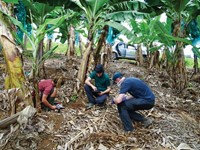Advertisement
Grab your lab coat. Let's get started
Welcome!
Welcome!
Create an account below to get 6 C&EN articles per month, receive newsletters and more - all free.
It seems this is your first time logging in online. Please enter the following information to continue.
As an ACS member you automatically get access to this site. All we need is few more details to create your reading experience.
Not you? Sign in with a different account.
Not you? Sign in with a different account.
ERROR 1
ERROR 1
ERROR 2
ERROR 2
ERROR 2
ERROR 2
ERROR 2
Password and Confirm password must match.
If you have an ACS member number, please enter it here so we can link this account to your membership. (optional)
ERROR 2
ACS values your privacy. By submitting your information, you are gaining access to C&EN and subscribing to our weekly newsletter. We use the information you provide to make your reading experience better, and we will never sell your data to third party members.
Environment
Coca Farming Linked To Deforestation In Colombia
Conservation: National parks emerge as tool against forest loss and new drug plantations
by Christopher Pala
January 20, 2011

Coca plantations are associated with major deforestation in tropical forests in Colombia's sparsely populated south, according to the first study to quantify the phenomenon (Environ. Sci. Technol., DOI: 10.1021/es102373d).
"Coca cultivation was at least as damaging to these forests as all the other factors combined – and I mean mining, oil drilling, logging, cattle ranching, biofuels, and food crops," says Liliana M. Dávalos of the department of Ecology and Evolution at the State University of New York, Stony Brook.
She and colleagues in the U.S. and Colombia analyzed satellite images to quantify the growth in the cultivation of coca, the plant whose leaves contain the alkaloid cocaine. In the satellite imagery, coca's bright green color stands out against the darker forest canopy. To confirm that plots were growing coca, the researchers then studied aerial photographs taken by the United Nations Office on Drugs and Crime (UNODC) of key coca-growing areas.
Most of Colombia's coca is grown in the country's rural south. Forest cover in the region fell from 82% to 78% between 2002 and 2007, a loss of 14,000 km2, which is about the area of Connecticut. The researchers found that areas near new coca plots were more likely to have experienced greater forest loss, even after controlling for other factors. "Coca cultivation was expanding at an even higher rate in the late 90s, but we didn't get good enough satellite data until 2002," Dávalos says. (The researchers did not find the relationship between coca plots and deforestation in the central and northern regions of the country.)
Coca growers typically try to evade detection by working in poor, remote areas with little law enforcement, Dávalos says. In Colombia, those areas are also likely to have forests. However, actual coca plots replaced very little forest area, she says: only 890 km2. "There's a lot more deforestation around coca plantations than was previously known," she says. The tree loss surrounding the plantations may occur due to grazing, food plantations, or other activities related to population growth, she adds.
Typical tactics to eradicate coca plantations, such as spraying herbicides, don't seem to protect the threatened forests. Other researchers have shown that coca growers leave after spraying, but the plantations switch to other crops instead of reverting to forest.
But the study uncovered one surprisingly effective way to prevent deforestation: The researchers saw slower deforestation in national parks. "In otherwise identical forests of 100 km2 in the south of the country, the protected areas lost roughly 0.7 km2 and the unprotected 1.6 km2," Dávalos explains.
Dávalos suspects that coca growers avoid the parks because they know that they can never own the land. UNODC surveys have shown that like other forest colonizers, coca growers in Colombia typically hope to gain title to the land they use. As a result, she says, designating a forest as a national park might remove some of its allure to coca growers and other colonists.
"The striking implication of this new, powerful analysis is that the authorities would do well to consider investment in conservation as a strategy towards preventing such illicit activities, over and above its other societal benefits," says Thomas Brooks, chief scientist with NatureServe, a nonprofit conservation organization.





Join the conversation
Contact the reporter
Submit a Letter to the Editor for publication
Engage with us on Twitter